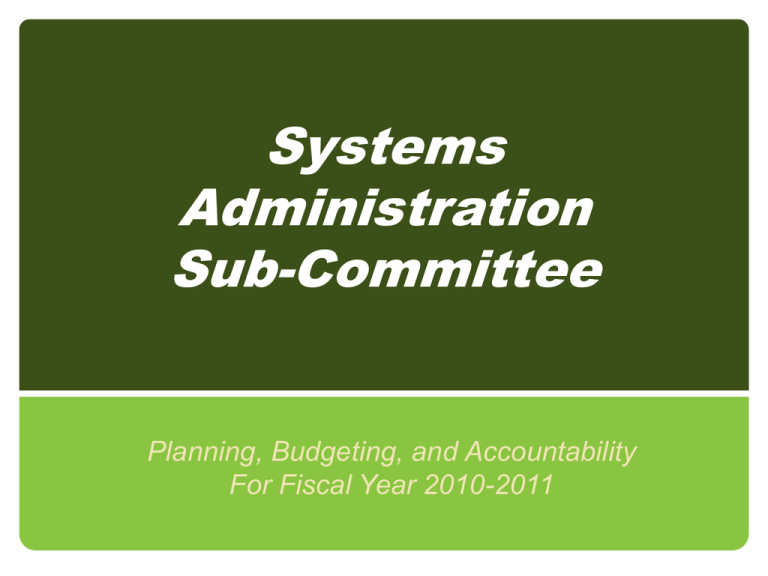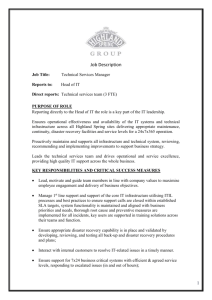Systems Administration Sub
advertisement

Systems Administration Sub-Committee Planning, Budgeting, and Accountability For Fiscal Year 2010-2011 Committee Membership Brett McKeachnie (Chair) IT Systems Administration Darel Hawkins IT Center for Student Computing Kevin Young School of Technology and Computing Mike Duffin IT Automation and Integration Kurtis Olsen Telephone Services Gerald Bunker IT HelpDesk Daniel Hutchison IT Systems Administration Mission, Scope, and Responsibilities The Systems Administration Sub-Committee exists to evaluate and recommend criteria for Best Practices, Strategic Directions, and Interoperability of Technology Systems at UVU. The scope of the committee includes decisions and recommendations regarding Hardware, Operating Systems, Data Storage, Backups, and Critical Application Level Software. The responsibilities of the committee include the development and implementation of PBA initiatives that support the IT Strategic Directions, the development of accountability measures, and the evaluation of outcomes. Department Personnel Systems Administration Brett McKeachnie Roark Fisher Daniel Hutchison Ted Blaney Paul Nuffer Alan Castle Automation & Integration Mike Duffin Chris Jones Dave Nielsen Wayne Wilson Landon Conover Brett Partridge Competencies Servers (Hardware, Operating Systems) Systems (Automation, Integration, Design, Security) Data Storage (Performance, Allocation) Disaster Recovery (Backups, Replication) Data Center Resources (Needs, Access) Making it all “work together, work right, work even when parts of it fail” (http://www.sysadminday.com/whatsysadmin.html) Vision A robust systems environment and ecosystem that is flexible and customer oriented, that provides security and resiliency, that simplifies integration and masks complexity, and that is fiscally and environmentally efficient. Guiding Values Customer Service Best Practices Flexibility Efficiency Collaboration Robustness Best Effort Reliability through stability Challenges Growth in demand for services and systems has not been matched by growth in employee headcount – Need more people and to keep the people we have. Operating under a historical paradigm which includes structural (training, mindshare, infrastructure) dependencies upon specific technologies that are becoming less capable of meeting the demands of our users – Need a paradigm shift. Agenda SWOT Analysis Cost Reductions Urgent Needs Pain Points Strategic Planning Requests SWOT Analysis: Strengths Team (quality people) Identity Management System Hardware (largely new or newer) Centralization/Core (efficiency) New Data Center Internal Communication (within IT) SWOT Analysis: Weaknesses Microsoft Training/Experience Apple Training/Experience User Communication User Training Staff Numbers Support for Mobile Devices Disaster Recovery Documentation SWOT Analysis: Opportunities Centralize in DLC Virtualization - Server Virtualization - Desktop Linux / Open Source Software Disaster Recovery Equipment Grant SWOT Analysis: Threats Novell Dependencies User Demands Phishing/MalWare Funding Apathy/Lack of Participation User Security Training Cost Reductions? Outsource? Cloud? Software Licensing? Virtualize Servers Virtualize Secure Servers Virtualize Desktops Transfer Servers to DLC Data Center Urgent Needs Automation and Integration Staff Disaster Recovery Equipment Progress is being made • Banner database and app server in Richfield Needed • Off-Site Backup • Disk Space Usage Reduction • Improved Data Transfer to Richfield • Critical Systems/Processing for Emergencies (Virtualized) • Communications • Urgent Financial Needs Pain Points AKA “What Keeps Brett Up at Night” Can't Get Enough Done Possible Loss of Key Staff Novell Company Policies / Relationships Future Directions / Questionable Viability User/Administration Perceptions/Support Strategic Planning Microsoft (Discovery, Training, Planning) Disaster Recovery (Planning, Equipment) Use DLC Data Center (Increase Efficiency) Microsoft Proactive Discovery Process to Determine Costs of Changing Benefits to be Gained Pitfalls to Avoid and/or Be Aware Of Methods to Employ Changes Required What do we expect to learn? Costs – Financially Expensive (Licensing, Support), Migration Costly if Consultants are Used, Need More Administrators, More Servers, Lots of Training Required, Time Investment, Parallel Deployment, Major Adjustments to IDM Systems Benefits – Increased Integration with 3rd Party Systems and Devices, Market Share (Easy to Find Help and Training) What do we expect to learn? Pitfalls – Not a Panacea, Trade One Set of Problems for Another, Systems Can Get Very Large, Compliance Issues, More Exploits (Market Share) Methods – Many Best Practices, Different Paradigms (Adapt Our Thinking), Adjust to Different Strengths & Weaknesses Changes – Few Visible Differences, E-Mail Client Change (Expect Detractors), Administration/Management Completely Different, Numerous Additional Systems Possible (SharePoint) Why Not Novell? Policies Maintenance Required for Patches Maintenance Required for KnowledgeBase ShareHolders / Board Short Sighted – Looking for Buyout? Development Moved Offshore Prices Increasing, Despite Market Share and Economy Premium Attitude, Inferior Products Wait for partners to build solutions, then re-invent the solution to sell, putting partners out of business Support Quality Poor / Finger Pointing OffShore (Language/Culture Barrier) Knowledgebase Constantly Changing, Difficult to Find Answers Products Quality Poor Require Patches for Functionality Reduced Features in New Versions Integration of Systems and Devices Difficult Partners (and some Novell Products) Delayed or Refused Support for Linux – Left Market Future Important Partners Leaving Customers Leaving Market Share / Mind Share Difficult to Get Training Difficult to Find Experienced Help Constant Rumors about Future Changes/Improvements? “Too Little Too Late” –Joe Martin Why Not Apple, Linux, or SUN? Don’t Scale for Windows and MAC Clients No Collaboration Suite Available Similar to Novell’s Lack of Integration Why Microsoft? Market Share / Mind Share Easy To Find Trained Help Any Problem We Have, Many More Also Have Same Benefits Achieved in Move to Cisco from Alcatel Integration Mobile Devices Enterprise Systems Extensive Partner Network Administration Support “Why haven’t we moved to Microsoft yet?” “When are we going to move to Microsoft?” “If we were on Microsoft, my <product> would work.” Questions Is This Just An Emotional Reaction? No. We can plan now, or we can try to figure it out under pressure if/when it’s required. Won’t This Be Expensive? Yes. But we don’t yet know how much it will cost. That’s one of the things we need to learn. Won’t This Be a Very Difficult and Problematic Move? Yes. That’s why we need to plan. Are We For Sure Moving to Microsoft? No. We want to investigate, learn, plan and budget to determine if it’s the right move for UVU. When Would We Make This Change? Guessing, I’d say 3 to 5 years to prepare and move. Disaster Recovery Data De-Duplication Devices (Orem & Richfield) Off-site backup Improved disk space usage Improved data transfer between sites VMWare Host(s) at Richfield Web Server Critical Services/Processing (Payroll, Purchasing) Emergency E-Mail System, etc. Data Center Usage No financial costs Create a single point of contact empowered to help departments move in. This is in progress in Infrastructure Services Requests Ongoing Funding Positions • Systems Administrator – AIS • Application Administrator – VMWare • Systems Specialist – AIS Equity/Career Ladder Upgrades • Alan, Chris, Dave, Paul One Time Funding Disaster Recovery Equipment ($250,000) Microsoft Discovery/Training/Planning ($30,000) Summary/Conclusion We Add value by creating systems that work better, meet our unique needs, and help people do their jobs more efficiently. Need help in the form of positions in the AIS Department and equity funding so we can keep key employees. Need to put some basic DR equipment in place to augment the systems we have been granted – A basic infrastructure we can build upon. Need to look seriously at alternatives to Novell technologies, so we have a plan to meet our needs, come what may. The End





